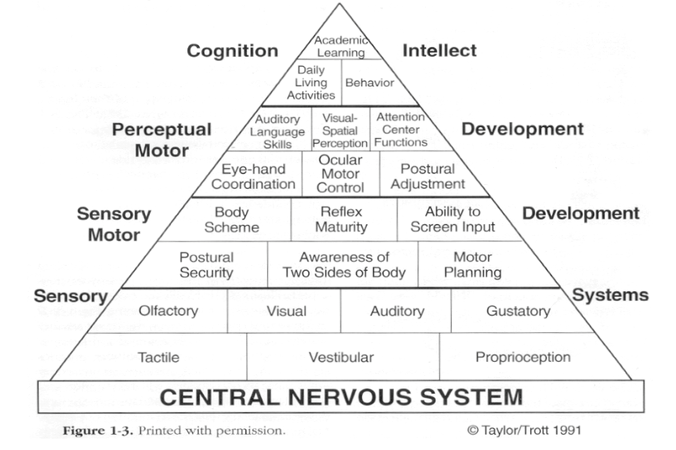
The Pyramid of Learning
(By: Anna Reeves OT)
The Pyramid of Learning was developed by Kathleen Taylor (Occupational Therapist) and Maryann Trott (Special Educator) in 1991. They based this pyramid on the research done by an Occupational Therapy research and Guru of Sensory Integration Therapy Jean Ayres.
The pyramid helps us understand the importance of having firm foundations from which our children can build their skills upon.
The very first level at the bottom is our Central Nervous System. How is the child’s regulatory system (sleep, diet, elimination patterns, breathing patterns, etc.) going? This is closely linked to the second tier which is our sensory system.
Our sensory system consists of 8 senses, 7 of which are included in the diagram. Tactile, vestibular, proprioception, (and interoception- which is not included in this diagram) underpin the other sensory systems.
- Tactile (touch)
- Vestibular (Balance and movement of the head in relation to space)
- Proprioception (knowing where their bodies are in space and in relation to different parts of the body)
- Interoception (awareness of internal feelings such as hunger, urge to use the bathroom, sleepiness, etc.)
- Olfactory (smell)
- Visual (vision)
- Auditory (hearing)
- Gustatory (taste)
From here on we build on Sensory Motor skills which include:
- Body Scheme (body awareness through movement)
- Reflex Maturity (if primitive reflexes are retained, it has direct impact on learning.
- Ability to Screen Input (decipher what sensory information to pay attention to versus to ignore)
- Postural Security (Confidence to maintain body position without falling)
- Awareness of Two Sides of the Body or we call it bilateral integration.
- Motor Planning (being able to know how to move the body accordingly in order to achieve a novel task)
Perceptual Motor Development builds upon Sensory Motor skills. Perceptual motor skills is a fancy way of saying…being able to move according to what the eyes understand.
- Auditory Language Skills (hearing and responding)
- Visual Spatial perception (understanding distance, making sense and moving their bodies successfully according to what they see and understand in space)
- Attention Center Functions (keep paying attention)
- Eye-hand coordination (moving their bodies according to what they see)
- Ocular Motor Control (focus, locate, scan, fixate)
- Postural Adjustment (adjusting their posture in order not to fall)
Cognition Intellect is the top tier and this is often what we see and what brought the children into therapy in the first place. This includes:
- Academic learning
- Daily Living Activities (toileting, dressing, eating, bathing)
- Behaviour
This doesn’t mean we shouldn’t work directly on the challenges seen on the top tier, but rather the pyramid helps us understand that there is often more going on under academic challenges, behavioural struggles, and not being able to be independent with activities of daily living. Ideally, we need to work on these skills in conjunction with building a solid foundation.
